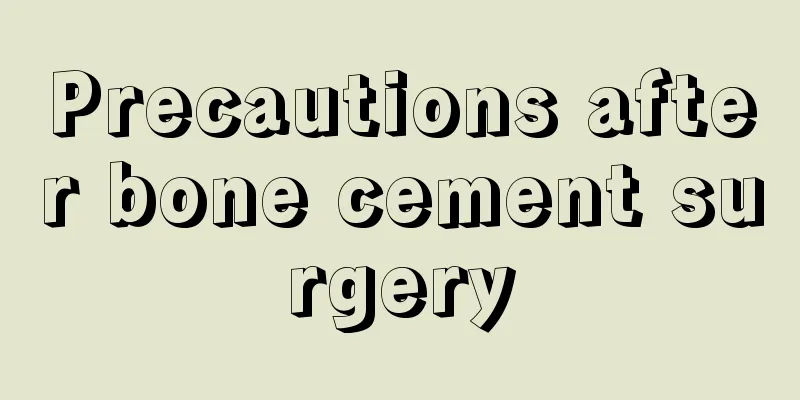Precautions after bone cement surgery

|
After the operation, you need to rest in bed for 2 to 4 weeks, after which you can go out for activities and eat more high-protein and high-calcium foods. In order to better recover the body, gradually increase activities and improve functional training. Just maintain a regular diet and rest schedule and relax. So, besides the above, what else should you pay attention to? Let's now look at the methods and steps Methods/Steps 1 Pay attention to changes in blood pressure Although lumbar bone cement surgery is a minimally invasive surgery, it also requires general or local anesthesia. Some elderly people cannot cooperate with the surgery and can only use general anesthesia. General anesthesia is risky for the elderly. Many unexpected situations may occur during and after the operation, especially a sudden drop in blood pressure. Therefore, even if the operation goes smoothly, blood pressure changes must be closely monitored after the operation, especially in the first three days after the operation. 2 Watch for changes in breathing It is very important to observe changes in breathing after surgery, especially for the elderly. The elderly have relatively weak lung function, and the suppression of breathing caused by anesthesia surgery can easily cause coughing and sputum. The sputum cannot be coughed up and blocks the respiratory tract, which can easily lead to lung infection. Early detection of breathing changes and timely measures can not only help the elderly safely pass through the critical period after surgery, but also save their lives. 3 Pay attention to high-nutrition diet Because bone cement surgery is a minimally invasive surgery, you can start eating as long as you are awake after the surgery. Eat more high-protein, nutrient-rich foods. At the beginning, you can eat more easily digestible liquid food, such as millet porridge, chicken soup, pork rib soup, fish soup, vegetable and lean meat porridge, etc. You can eat normally after two days, and you can eat sea cucumbers, yam, pork ribs, various fresh vegetables and fruits, etc. While ensuring nutrition, it is necessary to combine meat and vegetables. 4 Pay attention to moderate activity every day Lumbar bone cement surgery is a minimally invasive surgery. If the elderly person is in good physical condition and has no surgical complications, he or she can sit up within 24 hours; after 48 hours, he or she can get out of bed and stand once a day to move his or her limbs; after three days, he or she can walk with support by the bed or with the help of a walker, and gradually transition to walking on his or her own. But you must grasp the right degree, never walk too much at one time, and you must proceed step by step. 5 Pay attention to controlling underlying diseases The elderly generally have underlying diseases, such as hypertension, diabetes, coronary heart disease, etc. Anesthesia and surgery will have adverse stimulation on people. In addition, long-term bed rest can easily cause increased blood pressure, increased blood sugar, coronary heart disease attacks, etc. Therefore, blood pressure and blood sugar should be checked every day after surgery. The original regular medicines can be continued after consultation with the doctor to keep blood pressure and blood sugar within a normal range and prevent the occurrence of complications. 6 Pay attention to TCM-assisted rehabilitation The elderly have relatively weak body functions and they also have underlying diseases. Some people recover very well after bone cement surgery; some others will experience low back pain, weak legs, and inability to walk on their own. In this case, they need to go to a regular Chinese medicine hospital for rehabilitation treatment. Acupuncture on acupoints, meridian massage, etc. can be of great help to recovery. You can also take some decoctions or Chinese patent medicines to help your body recover according to your condition. 7 Pay attention to regular orthopedic check-ups If the recovery is normal after bone cement surgery, there is no need for further examination; if low back pain, leg pain, weak legs, inability to walk on your own, etc. occur, you need to go to the hospital where the surgery was performed for a CT or MRI, and then find the surgeon for further examination to confirm whether it is related to the bone cement surgery or to your own condition, and to determine further treatment plans. |
<<: Postoperative rehabilitation training for femoral head
>>: There is a bone protruding from the back of the head
Recommend
How to do drug chemotherapy for bladder cancer
Chemotherapy is a common treatment for various tu...
What should liver cancer patients eat in life? 4 things to note when eating tonic food for liver cancer patients
Liver cancer is insidious, has a long latent peri...
What does window period mean?
Many people do not understand what the window per...
What are the exercises to recover from calf atrophy
When symptoms of calf muscle atrophy appear due t...
What is the reason for high uric acid? It is actually related to these factors
According to experts, the disorder of purine meta...
Tips for cleaning a dirty purse
Leather bags are people’s good companions in dail...
How to make egg and olive oil mask
Nowadays, many people pay more attention to their...
The dangers of severe primary pulmonary hypertension
Primary pulmonary arterial hypertension poses a g...
What are the symptoms of lung cancer? If you have these 4 symptoms, be careful that it is lung cancer
Everyone is very afraid of cancer. The reason for...
The hair is black, thick and hard
Both men and women pay a lot of attention to thei...
What to do if red blood streaks appear on the face
As the saying goes, "Everyone loves beauty.&...
Does swollen eyes have anything to do with kidneys?
Kidneys are the metabolic organs of human beings....
What to do if you find thyroid nodules, specific treatment methods
Now many people have thyroid nodules. Don’t be to...
The huge harm of prostate cancer to men
Health is a matter of concern to all of us. In re...
How to ferment tofu dregs
Many people in our daily life like to eat tofu, a...









